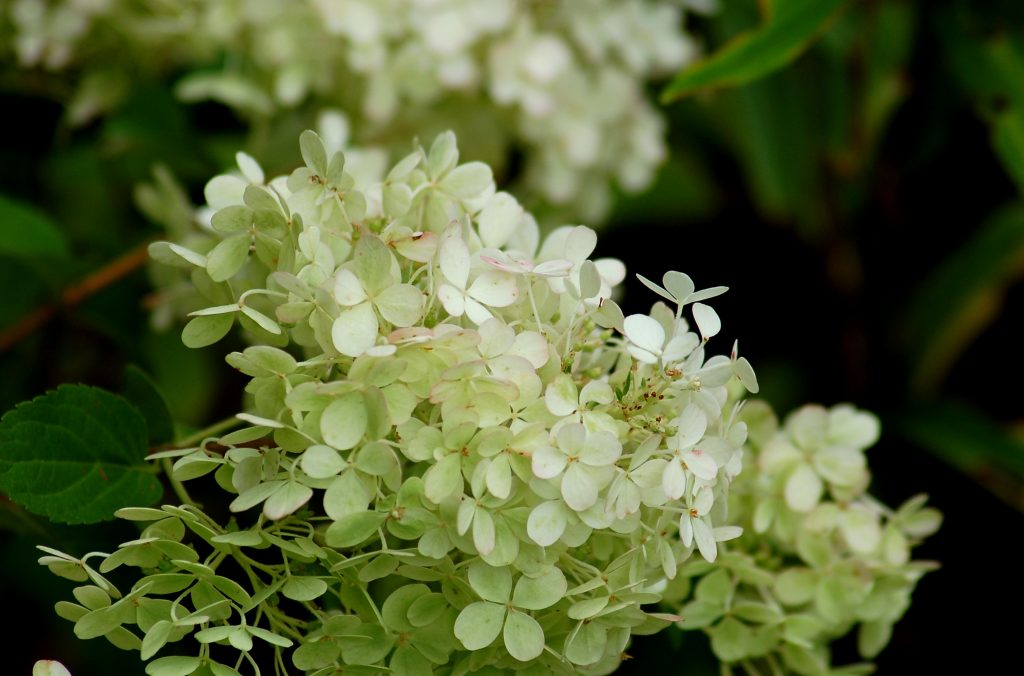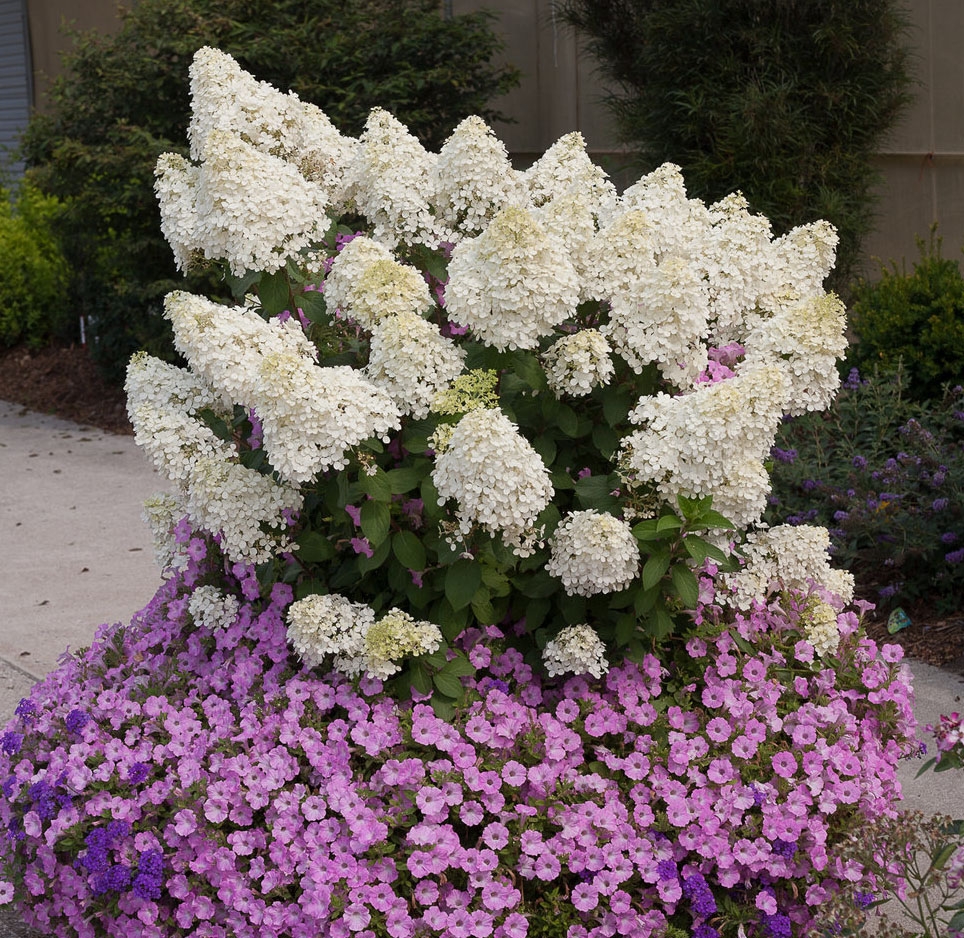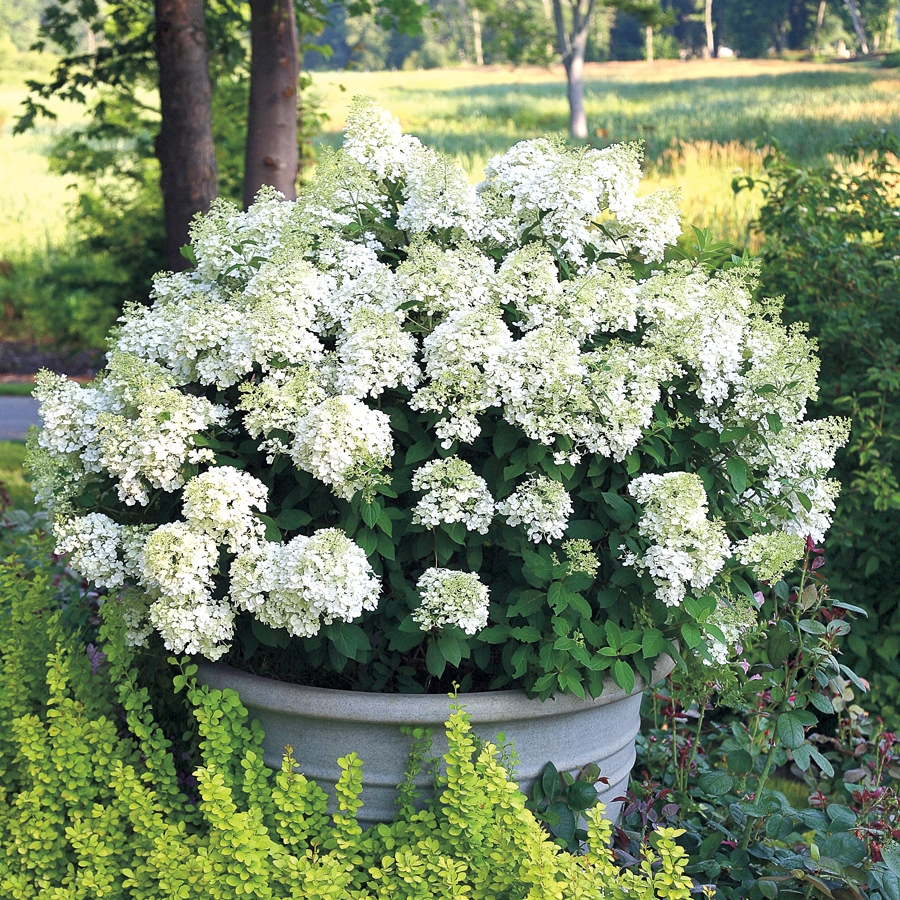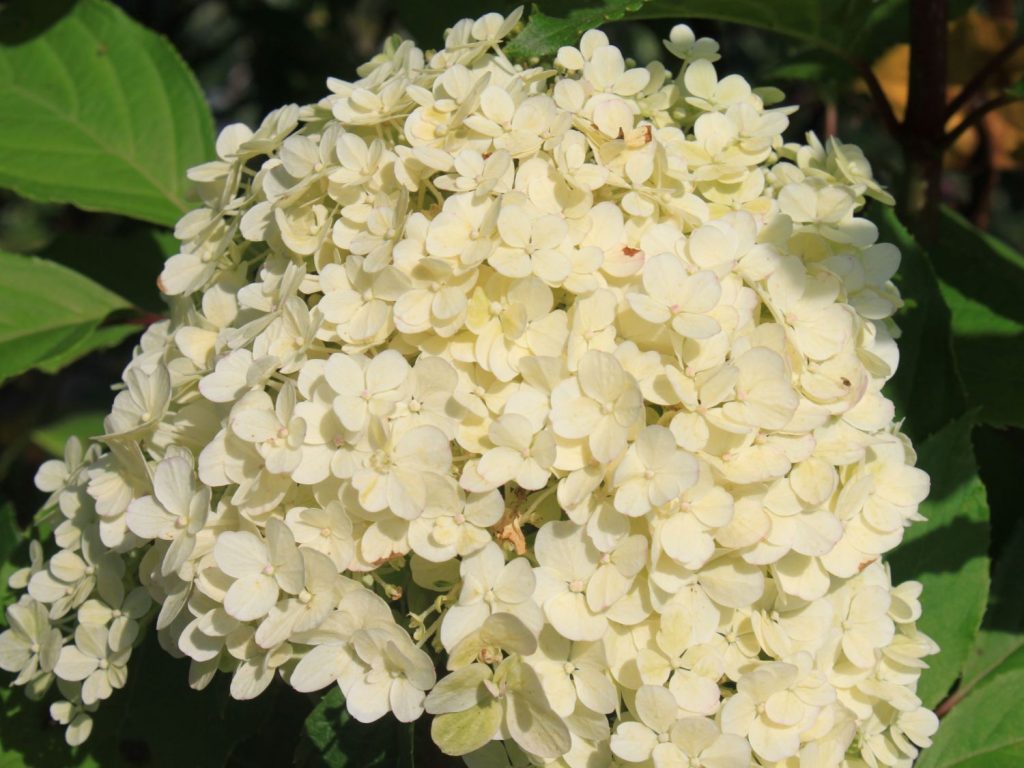Hydrangea paniculata Bobo - a detailed description of the variety
Bred by Belgian breeders, the Bobo hydrangea was awarded in 2011 at the florall exhibition in Ghent. It is considered one of the best winter-hardy varieties with high decorative qualities. Consider its characteristics, as well as the rules of planting, care and reproduction.

Hydrangea bobo photo and description
Description of the plant
The Bobo panicle hydrangea is a dwarf species. The height of the bush is 60-70 cm, diameter is 50-60 cm. During the season it grows by 10 cm in length.
The scientific name of the variety is hydrangea paniculata Bobo.
External description:
- stems are tough, brown, erect;
- leaves are oval, green, with jagged edges;
- flowers are small, greenish-white, collected in wide pyramidal inflorescences, closer to autumn they acquire a pink tone;
The plant has good frost resistance, winter hardiness - it can withstand temperatures as low as -35 ° C. It blooms for a long time - from July to September.
High immunity against diseases and pests is maintained, provided that all the rules of agricultural technology are observed.
Landing features
To grow a strong bush that will bloom magnificently and continuously, you must adhere to some growing rules.

Hydrangea paniculata bobo description
Timing
Planting is carried out in early spring, so that during the season the seedlings have time to take root and prepare for winter.
Depending on the region, the dates are different - from mid-March to the first decade of April. The main thing is that the soil warms up to 10-12 ° C and the threat of return frosts is avoided.
It is also important to have time to do this before the beginning of the growing season, when the leaves have not yet begun to bloom.
Seat selection
Prefers to grow in a well-sunlit place. It is better to plant away from trees and shrubs, otherwise the plant will suffer from a lack of moisture, nutrients and light.
It grows poorly in a swampy place, so choose an area with groundwater occurrence to a depth of 3 m.
The soil is suitable for light, loose, enriched with organic matter. Can be planted on sandy loam or loam. The optimum acidity level is 6-7 units. If this figure is higher, the place for planting is sprinkled with dolomite flour, slaked lime or chalk at the rate of 400 g / m².
Prepare the site in advance - in two weeks they remove garden debris, plant residues. Then it is dug up and leveled.
Preparation of planting material
You can buy seedlings of this variety in one of the flower shops. It is better to give preference to grown specimens, which have a branched crown and a well-developed root system.

Hydrangea bobo
Typically, the bushes are sold in containers or pots. Plants with open roots are not worth buying, because they may not take root after planting on the site.
When choosing, inspect the stems, leaves - they must be fresh, without signs of pest disease.Any growths, cracks, breaks indicate the non-viability of the seedling, which is better to refuse.
Before planting, the plant needs to be prepared - water abundantly, remove from the container, cut the roots by 3-4 cm in order to stimulate the growth of new shoots after planting.
Landing technique
Pits are dug a little larger than the root system - 60x70 cm. A little drainage is poured into the bottom - pebbles or rubble. Such material contributes to the rapid outflow of excess moisture. Then it is half filled with light and fertile soil. Peat, dug earth, sand and humus are mixed in the same amount.
The roots are lowered, straightened, all voids are covered with soil, trampled around the trunk, watered. To keep moisture in the soil as long as possible, the near-trunk zone is mulched with rotted manure or peat.
When planting, it is important not to deepen the root collar, because when moistened, it will quickly rot and the shrub will die.
If you plant several seedlings at the same time, you need to maintain a certain distance - about 1 m, in a row - 80-90 cm. So the plants will fully develop, without experiencing a lack of moisture and nutrients.
Care
Watering
In spring and summer, it is watered every 3-4 days, while making sure that the soil dries out to a depth of 4-5 cm.
If the summer is rainy, you do not need to moisturize. Excess moisture can quickly rot the roots.
Closer to autumn, the frequency is reduced to once every 2-3 weeks. Use warm and settled water.
The next day after moistening, the soil is loosened, weeded between the rows, and weeds are removed. Mulch the near-trunk zone with peat or humus to prevent rapid evaporation of moisture.
Hydrangea responds positively to crown sprinkling once a week. This will help wash away dust, stimulate the growth of new shoots, leaves and protect against pest infestations.
Top dressing
Fertilizers are applied in two stages:

Hydrangea paniculata bobo photo
- In the last days of May, they are fed with a slurry solution. In addition, a mineral composition is added to it, intended for the cultivation of decorative flowering shrubs (superphosphate, ammonium nitrate and potassium nitrate). Dosage according to the instructions on the package. Such nutrition stimulates intensive growth, lush and long flowering.
- In the fall, after the end of the growing season, compost or last year's manure is embedded in the soil. It will provide additional insulation and enrich the soil with useful substances.
All root dressing is combined with watering. Moisture will help absorb fertilizer faster and protect the root system from scalding.
Pruning
This procedure is carried out from early March to mid-April, depending on the climatic conditions of the region. The main thing is that the frost ends and the temperature reaches 1-3 ° C. A sharp and sterile instrument is used, after cutting the cut sites are treated with copper sulfate.
Several of the strongest stems are selected on the bush, the rest are cut into a ring. The number of shoots that must be left depends on the vigor and age of the shrub. You do not need to prune them, since new buds will form on the tops in the future.
Additionally, you should leave a few young stems in the area of the root collar. They will serve as a substitute for faded shoots.
Together with this procedure, the crown is thinned out, because it is prone to thickening. Cut branches growing inward and at the wrong angle. Broken, dry, frozen and disease-damaged stems are also removed.
Anti-aging pruning is needed for old specimens - 8-9 years old. All shoots are shortened to a stump or perennial wood. The next year, such bushes may bloom.
Preparation for wintering
Despite the good frost resistance and winter hardiness, young plantations up to three years old require shelter for the winter. Warming is started after pruning 10 days before the upcoming frost:

Hydrangea paniculata bobo
- the near-trunk zone is mulched with peat or humus;
- the branches remaining on the bush are bent to the ground, pinned;
- sprinkle with fallen leaves or spruce branches, lay slate on top.
They remove the shelter in the spring, when the snow thaws and the threat of return frosts has passed.
In the future, adult hydrangeas do not insulate, but mulch with compost or rotted manure.
Reproduction
Cuttings
Harvesting and planting is done in the spring during shaping and sanitary cutting. For growing, twigs of the current year with internodes, several leaves and buds are suitable. In the lower part, all the foliage is cut off, then dipped into one of the root formation stimulants.
After an hour of soaking, they are planted in a light and loose substrate of peat and sand to a depth of 3-4 cm. The plantings are moistened, watered with warm water, covered with transparent material to create a greenhouse effect.
They are kept on a windowsill with diffused daylight and a stable temperature in the range of 20-25 ° C.
Rooting can take 3-4 weeks. As soon as the stems release new leaves, the shelter is removed, they continue to grow for another month, then they are planted in the open ground.
Layers
This method is suitable for mature plants that have lignified stems close to the soil. Next to the bush, a trench is dug 4-5 cm deep. Sprinkle with a wet mixture of peat, sand and humus (1: 1: 1).
The twig is freed from the leaves, laid in a horizontal position, pinned with staples, covered with soil mixture, watered.
Before the onset of autumn frosts, they are covered with fallen leaves or humus. They are dug up in the spring when the threat of return frosts has passed. Cut from the mother bush, divide into parts so that each has roots. Cutting points are treated with copper sulfate. They are seated separately in the garden.
By dividing the bush
Such reproduction is advisable for old bushes that need to be rejuvenated. With age, they stop growing, they do not bloom so magnificently and for a long time.
Hydrangea is watered abundantly, dug out, the roots are washed from the rest of the soil. Divide with a shovel into several parts, so that each has roots and at least one shoot with leaves and buds. Places of cuts are treated with a fungicide, allowed to dry.
They are seated separately on the site, moistened, shaded from the sun in the first weeks.
Diseases and pests
Hydrangea paniculata Bobo rarely gets sick, infection is possible only if the rules of agricultural technology are violated and grown in a neglected area:

Bobo hydrangea description reviews
- Rust. Signs - leaves and stems are covered with red spots. The fungus provokes decay and death. First you need to remove all the diseased parts, then treat the crown with Ridomil Gold, Skor or Hom.
- Powdery mildew. It develops in conditions of high humidity and high temperatures. Fungal infection manifests itself in the form of a whitish powdery plaque. Over time, it darkens, the lesions turn yellow, die off. Fungicides will help to cope with this sore - Bordeaux liquid, copper or iron sulfate.
- Aphid. A small insect that multiplies quickly and can destroy the entire bush in a short time. It settles on the inside of the leaves, feeds on their juice, which leads to wrinkling, drying out and falling off. At the initial stage, you can carry out the treatment with an ash-soap solution or tobacco infusion. If it does not help, you will have to resort to chemistry - irrigate the crown and leaves from all sides with Karbofos or Fitoverm.
- Spider mite. Another sucking parasite that appears in extreme heat and drought conditions. He loves to feast on the juice of the leaves, as a result of which they are covered with a marble pattern. Leaves curl, dry and crumble. Double treatment with Aktellik or Aktara is required.
For prevention, gardeners recommend buying healthy seedlings, following the scheme for their transplantation to the site. Water, prune and feed regularly.It is also worth keeping the flower garden clean - remove weeds on time, periodically loosen and weed the aisles.
Application in the garden
In landscape design with ort Bobo takes a special place:
- it is planted singly in flower beds, near gazebos, terraces;
- used in group plantings with other flowering perennials - roses, rhododendrons, tree varieties of hydrangeas;
- used for landscaping the garden in different styles - Japanese, Scandinavian, English, rural;
- a composition of evergreen soil-cultivators and dwarf conifers (junipers, firs, dwarf thujas) and hydrangeas looks spectacular.
Testimonials
The dwarf variety of panicle hydrangea has received many positive reviews from gardeners:

Hydrangea paniculata hydrangea paniculata bobo
- unpretentious in care, easily withstands severe frosts and practically does not get sick, which makes it possible to grow it everywhere;
- due to its compact size, the shrub is suitable for planting in small areas;
- well tolerates the neighborhood of any vegetation in the garden or flower garden.

